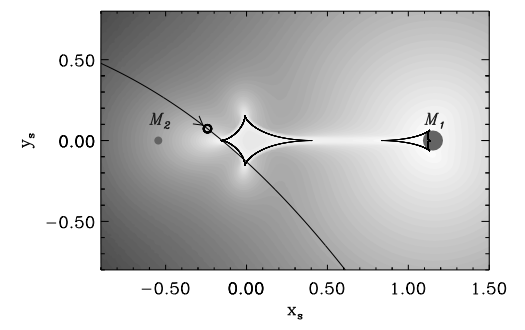First Planet Discovered Orbiting a Brown Dwarf
Astrophysical calculations show that any star that is smaller than about 1/10th of the mass of the sun cannot sustain hydrogen fusion reactions at its core. These failed stars never light up. Instead they wander the galaxy as warm, dark balls of hydrogen known as brown dwarfs.

Brown dwarfs probably form through the same process that lead to ordinary stars but merely on a smaller scale. If that’s correct, planets should also form in the protoplanetary disks of gas and dust around brown dwarfs. Indeed, astronomers have seen a number of protoplanetary disks of this type.
Until now, however, they’ve never seen a planet orbiting a brown dwarf. That’s not really surprising.
The standard methods for detecting planets look for the way a star wobbles as a planet orbits or at how its magnitude changes as a planet passes in front. But given that brown dwarfs are dim and difficult to see, these methods have yet to produce fruit.
All that changes today with the announcement by an international team of astronomers that they’ve discovered a planet orbiting a brown dwarf the first time. These guys have made their discovery using an entirely different method of detection called gravitational lensing. This occurs when one body passes in front of another and its gravity focuses light from the more distant object towards Earth. That works regardless of the brightnesses involved.
The brown dwarf in question is almost 6000 light years from Earth in the Fish Hook constellation. Astronomers first noticed an unusual change in its brightness in April 2012. Further investigation showed that this was indeed a lensing event.
These guys conclude that the brown dwarf is being orbited by a planet about twice the mass of Jupiter at a distance of just under one astronomical unit. The brown dwarf itself is about 10 times larger than its companion.
That’s the first time astronomers have found an object orbiting a brown dwarf that can be truly described as a planet. The technical definition of a planet is that it must have formed in the parent object’s protoplanetary disk.
Astronomers have seen other planet-sized objects orbiting brown dwarfs but only at distances of several tens of astronomical units. That’s too far to have been part of the protoplanetary disk. “Thus,…,they are not bona fide planets,” say the team.
So that’s a modest first for this team. It raises the question of what kind of conditions exist on such a planet and, of course, whether these could support life.
This planet almost certainly does not fall into that category but where there is one planet, there are almost certainly others. Astronomers can now have some fun speculating on the Goldilocks zones around brown dwarfs where conditions are just right for life and how to spot the interesting planets inside them.
Ref: arxiv.org/abs/1307.6335 : Microlensing Discovery Of A Tight, Low Mass-Ratio Planetary-Mass Object Around An Old, Field Brown Dwarf
Keep Reading
Most Popular
Large language models can do jaw-dropping things. But nobody knows exactly why.
And that's a problem. Figuring it out is one of the biggest scientific puzzles of our time and a crucial step towards controlling more powerful future models.
How scientists traced a mysterious covid case back to six toilets
When wastewater surveillance turns into a hunt for a single infected individual, the ethics get tricky.
The problem with plug-in hybrids? Their drivers.
Plug-in hybrids are often sold as a transition to EVs, but new data from Europe shows we’re still underestimating the emissions they produce.
Google DeepMind’s new generative model makes Super Mario–like games from scratch
Genie learns how to control games by watching hours and hours of video. It could help train next-gen robots too.
Stay connected
Get the latest updates from
MIT Technology Review
Discover special offers, top stories, upcoming events, and more.